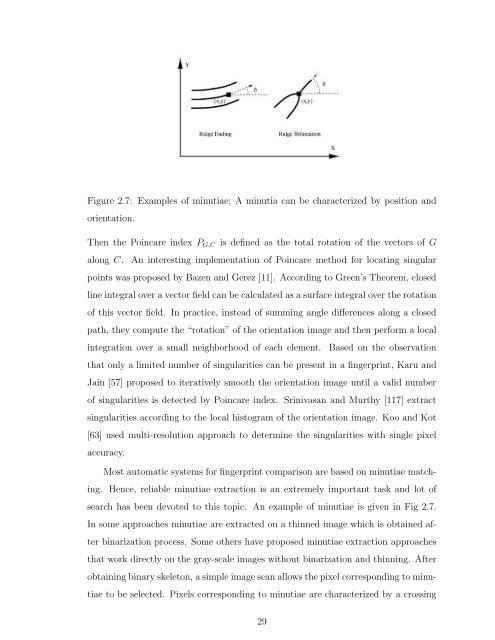Master Thesis - Department of Computer Science
Master Thesis - Department of Computer Science
Master Thesis - Department of Computer Science
Create successful ePaper yourself
Turn your PDF publications into a flip-book with our unique Google optimized e-Paper software.
Figure 2.7: Examples <strong>of</strong> minutiae; A minutia can be characterized by position and<br />
orientation.<br />
Then the Poincare index PG,C is defined as the total rotation <strong>of</strong> the vectors <strong>of</strong> G<br />
along C. An interesting implementation <strong>of</strong> Poincare method for locating singular<br />
points was proposed by Bazen and Gerez [11]. According to Green’s Theorem, closed<br />
line integral over a vector field can be calculated as a surface integral over the rotation<br />
<strong>of</strong> this vector field. In practice, instead <strong>of</strong> summing angle differences along a closed<br />
path, they compute the “rotation” <strong>of</strong> the orientation image and then perform a local<br />
integration over a small neighborhood <strong>of</strong> each element. Based on the observation<br />
that only a limited number <strong>of</strong> singularities can be present in a fingerprint, Karu and<br />
Jain [57] proposed to iteratively smooth the orientation image until a valid number<br />
<strong>of</strong> singularities is detected by Poincare index. Srinivasan and Murthy [117] extract<br />
singularities according to the local histogram <strong>of</strong> the orientation image. Koo and Kot<br />
[63] used multi-resolution approach to determine the singularities with single pixel<br />
accuracy.<br />
Most automatic systems for fingerprint comparison are based on minutiae match-<br />
ing. Hence, reliable minutiae extraction is an extremely important task and lot <strong>of</strong><br />
search has been devoted to this topic. An example <strong>of</strong> minutiae is given in Fig 2.7.<br />
In some approaches minutiae are extracted on a thinned image which is obtained af-<br />
ter binarization process. Some others have proposed minutiae extraction approaches<br />
that work directly on the gray-scale images without binarization and thinning. After<br />
obtaining binary skeleton, a simple image scan allows the pixel corresponding to minu-<br />
tiae to be selected. Pixels corresponding to minutiae are characterized by a crossing<br />
29










